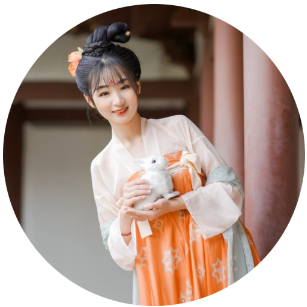
Traditional Chinese Clothing 汉服
作者 /李雨萌
指导教师 / 班海东 史潘荣 张泽妍
The Traditional Chinese Clothing, or literally “Clothing of the Han people”, refers to the traditional clothing of the Han Chinese, the predominant ethnic group of China.
汉服,即中国最大的民族——汉族的传统服饰。
From the reign of the legendary Yellow Emperor (2717BC-2599BC) to the end of the Ming Dynasty (1368-1644), the Traditional Chinese Clothing dominated the Han Chinese fashion world for a period of over four thousand years.
从传说中的黄帝(公元前2717年—公元前2599年)到明(公元1368年—公元1644年)末,在长达四千多年的历史中,汉服一直占据主流地位。
The Traditional Chinese Clothing disappeared after the invasion of the Manchus in the 17th century, under whose reign the Han Chinese were forced to adopt the Manchu hairstyle (the pigtail) and the Manchu-style clothing.
直至公元 17世纪,因满族建立的清政权强迫实行剃发易服而消亡。
After the collapse of the Qing Dynasty in 1912, the Manchu dress and the pigtail gave way to the western-style dress.
1912 年清朝灭亡之后,西式服装逐渐流行。
The basic style of the Traditional Chinese Clothing was established in the Zhou Dynasty (1046 BC-256 BC), including the Shenyi style, a full-length, one-piece robe which links the Yi and Shang together to wrap up the body; the Yi (the upper garment) and Shang (the skirt) style.
汉服定型于周朝(公元前1046年—公元前256 年),形制主要有“深衣”制(上下相连、被体深邃)、“上衣下裳”制(上衣、下裙)。
Main patterns include the diagonally crossed collar, the left lapel over the right, tight upper garment with loose sleeves, tying with sash in place of buttons, and the lower garment in the shape of an apron.
款式为交领右衽,褒衣广袖,系带隐扣,下裳类似围裙的形状。
Ornaments like tassels and jade pendants are worn hanging from the sash, to be completed with hats for men and hairpieces for women.
装饰上喜欢腰问佩带、佩玉,男加冠冕中帽,女子则宝署簪花。
The Traditional Chinese Clothing boasts a wide and profound influence.
汉服的影响十分深远。
Many traditional costumes of Asian countries, such as the kimono in Japan and Korean traditional dress, are derived from the Traditional Chinese Clothing and have preserved over centuries the pre-Manchu style of the Traditional Chinese Clothing.
许多亚洲国家的民族服饰都是汉服的衍生品。从日本的和服和朝鲜传统服饰中,仍能捕捉到满清之前的汉服的风采。
In recent years, there has been a revival of Hanfu as a Chinese national costume in China.
近些年,中国出现了主张将汉服作为中国国服的复兴潮。
The Traditional Chinese Clothing can be seen in some important worship, commemoration and traditional festivals in modern society.
一些重要祭祀、纪念活动、传统节日等都能看到汉服的影子。
Although Qipao and Tangzhuang are usually seen as traditional Chinese clothing, they are not regarded as the national costume by advocates of revival of the Traditional Chinese Clothing, since they are relatively recent clothing styles. Hence Qipao and Tangzhuang cannot represent the entire history of Chinese clothing.
而作为中国传统服饰的旗袍和唐装,因其历时较短,不能代表整个汉族服装的历史,所以主张汉服复兴的人士不将其归为汉服。

李雨萌
英语Z2202班
热爱阅读、旅游、汉服以及中国传统文化,曾获第十届陕西省挑战杯省级银奖;2019年陕西省大学生自强之星;2021年西安市“战疫新青年”;第七届“互联网+”陕西省铜奖;全国书画大赛“迎春杯”行草书法三等奖;第五届“鱼化龙杯”大学生创新创业大赛“雏鹰之战一等奖”;2022年第一届国际大学生英语词汇挑战赛一等奖;2022年BETT词汇大赛全国一等奖;2022年“读者杯”文学大赛一等奖;
任何限制都是从内心开始的,计划自己需要的,得到自己想要的。既然没有退路,每一步努力都是上坡。
